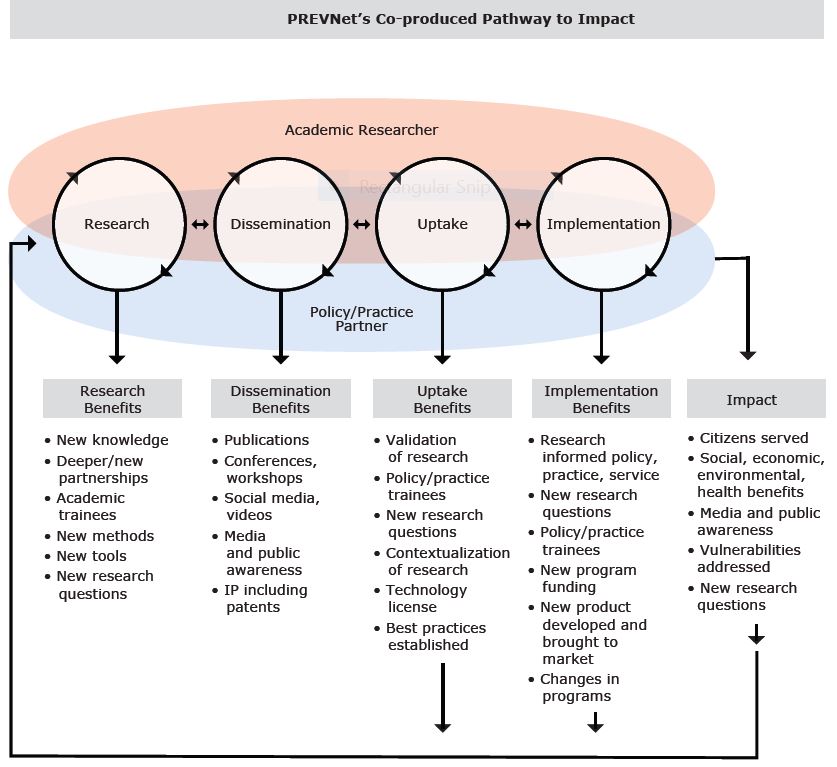York’s Knowledge Mobilization Unit regularly publishes peer reviewed articles on various aspects of institutional knowledge mobilization. The most recent publication describes a pathway from research to impact that can be used by research organizations seeking to monitor their projects as they progress towards impact.
L’Unité de mobilisation des connaissances de York produit régulièrement des articles scientifiques sur différents aspects de la mise en application du savoir universitaire. Sa publication la plus récente décrit un itinéraire permettant de passer de la recherche à l’impact, au moyen d’une démarche que les organismes de recherche peuvent employer pour superviser la progression de leurs projets vers l’impact souhaité.
Research impact is dominated by a few major frameworks including the Payback Model and the Knowledge to Action Cycle. The Payback Model was used as the basis for the Canadian Academy of Health Sciences (CAHS) Research Impact Assessment Framework which itself was antecedent of the Alberta Innovates Health Solutions (AIHS) impact assessment framework. The Knowledge to Action Cycle isn’t a good model for monitoring progress to impact in an organization since it was never meant to describe actions of a single organization. Payback (and hence CAHS and AIHS) separate the research (at the beginning) from impact (at the end) and do not embed collaboration throughout the research something that we know is key to mediating impact. Neither creates an explicit role for the end beneficiary (i.e. the patient) as part of the process.
The co-produced pathway to impact addresses some of these limitations. It mirrors the 5 stage model of CAHS/AIHS but it embeds collaboration at every stage. It also articulates some of the benefits accruing at each stage of the pathway that informs the choices of specific indicators. The pathway can be used as a model for policy impacts, commercial impacts and practice impacts but in all cases the end user (“citizens served” = patient, consumer, public) is embedded in the impact stage and thus engaged upstream in the design of the research phase by way of the feedback loop from impact back to research.

But here is the most significant contribution of this model. Check out the arrow pointing to impact. Impact is a function of non-academic partners not researchers. Researchers don’t make products, business partners do. Researchers don’t develop public policies, government partners do. And researchers generally don’t deliver social services, community partners do. Non-academic partners use the research evidence to inform products, policies and services that then have an impact on the lives of end beneficiaries. Therefore, to collect the evidence of impact you need to ask the non-academic partner not the academic researcher.
Published in the Journal of Community Engagement & Scholarship the pathway was illustrated by co-produced projects from the bullying prevention knowledge mobilization network PREVNet. It is this element of co-production throughout the pathway from research to impact that differentiates the co-produced pathway to impact from the other models which separate the research from the impact.
In addition to PREVNet, the co–produced pathway to impact is being used by some large research networks including NeuroDevNet and AllerGen as their impact framework. But it is only a model. It serves as a template that can be adapted and made specific to each project’s stakeholders, partners, research and activities all of which drive the choice of unique indicators to monitor the progress from research to impact. So enjoy your journey (with your academic and non-academic partners) from research to impact because now you have a map to guide you. The reference for the article is:
Phipps, D.J., Cummings, J. Pepler, D., Craig, W. and Cardinal, S. (2016) The Co-Produced Pathway to Impact describes Knowledge Mobilization Processes. J. Community Engagement and Scholarship, 9(1): 31-40.